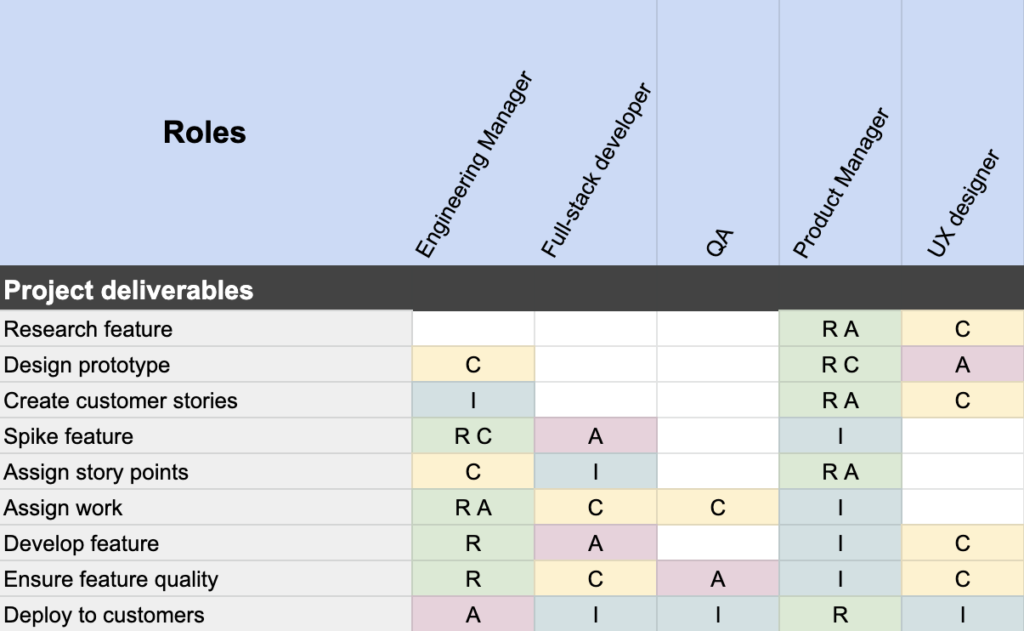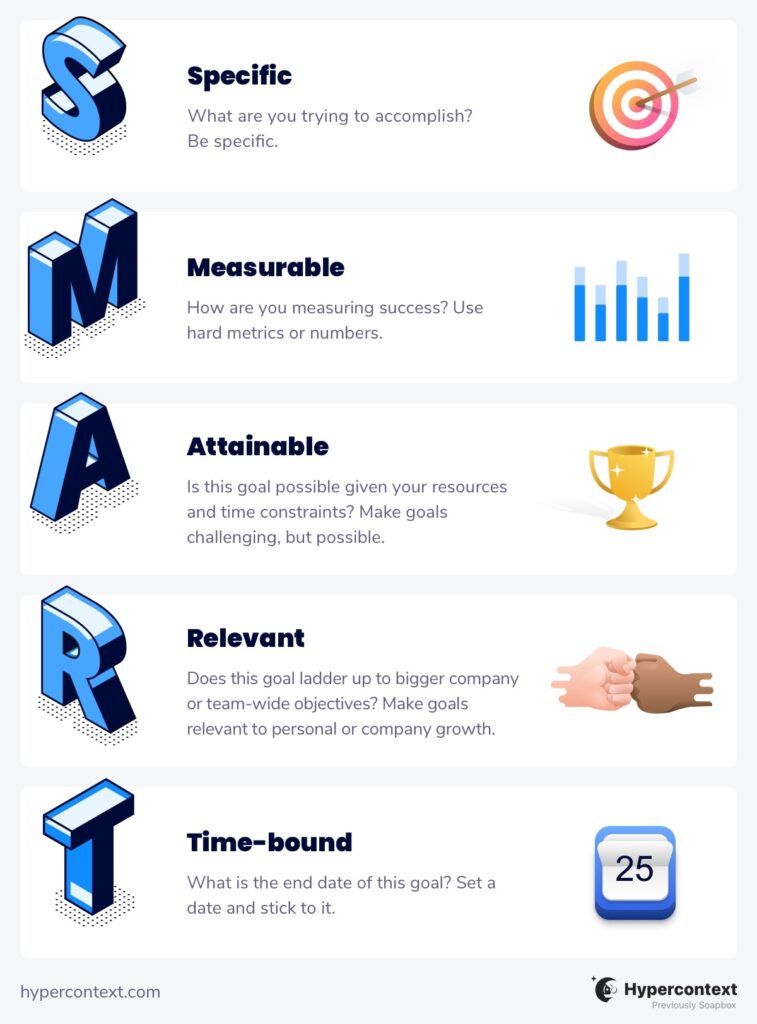5 Tips for better cross-functional collaboration
In this article we’ll explore the value of cross-functional collaboration at your company and best practices for improving how people work together across teams.
 Guest Contributor
Guest Contributor
Warning: Undefined array key "category" in /www/hypercontext_216/public/wp-content/themes/Soapbox/hype-files/sections/article/content.php on line 10
Cross-functional collaboration is the cornerstone of many modern workplaces. In short, it’s when people on different teams within an organization work together.
When every team works in a silo, it can be hard to achieve your company’s ultimate vision. After all, different functions need to work together and stay aligned in order to be successful.
However, cross-team collaboration may also be a challenging process — especially for people who are used to working independently or only with their functional team.
To help understand the value of cross-functional collaboration and overcome its challenges, this article sheds light on the following:
- What is cross-functional collaboration?
- Why is cross-functional collaboration important?
- Common pitfalls of cross-functional collaboration
- How to improve cross-functional collaboration
Let’s dive in for more details.
What is cross-functional collaboration?
Cross-functional collaboration is when a group of people from different teams work together to reach shared goals.
Every company is made up of many teams, with different responsibilities, all working towards the same ultimate goal.
For example, here are a few of the teams involved in building, promoting, and maintaining an app:
- The project managers develop the project plan, organize roles, and maintain communication across teams
- The UI design team makes a user-friendly design of the app, based on the project plan
- The front-end team bridges the app design and the available technology
- The back-end team manages the data between the server and the users
- The QA team supports the processes of planning, designing, and executing system tests
- The customer success team solves customer issues and answers customer questions to ensure a positive experience for users
- The marketing team creates content and carries out other marketing strategies to promote the app and increase conversion
- The sales team builds relationships with new leads and implements other strategies to increase app sales
While the teams above play different roles in the project, everyone is working toward the same ultimate mission: they want the app to be used by customers.
And, to establish a successful app, they need to communicate and collaborate with each other on a regularly. While contributing as individuals, teammates need to communicate closely and collaborate frequently on interdependent tasks — to reach their common goals.
Why is cross-functional collaboration important?
When you’re too zoomed into your own work, it’s easy to lose sight of the big picture and get caught up in details that may ultimately be insignificant. Cross-functional collaboration allows you to zoom out to understand what your peers are doing and how you can work together.
Working cross-functionally has several key benefits:
Increases innovation
Cross-team collaboration often results in more innovative ideas.
When you bring together teams whose members are diverse in terms of experience, education, and opinions, there’s more potential for innovation. After all, they have a larger pool of knowledge to explore and bring different perspectives to help find the best solution.
Encourages knowledge sharing
People working in cross-organizational teams need to collaborate with different types of professionals.
As a result, they have the chance to learn new skills and talents from each other and share their knowledge. And, knowledge sharing is beneficial for team performance — research cites it as “a process of great relevance that builds ties and relationships which in turn results in positive organizational and team outcomes”.
One reason it leads to positive outcomes for your team and organization? Better employee engagement. And, as a Gallup report shows, a highly engaged workforce increases profitability by 21%.
Improves company culture
When every team works in a silo, it’s not great for company culture. People feel isolated and struggle to see where they fit into the larger vision.
When people from different departments work together, it creates a greater sense of community within the company and a more inclusive culture. Now your engineering team knows your marketing team, and your marketing team knows your finance team — and everyone has an understanding of how their colleagues contribute.
Keeps your team aligned
Organizations that value cross-functional collaboration are more likely to communicate on a regular basis. And, frequent communication on an organizational level helps individual departments stay aligned with each other.
Everyone’s aware of who’s working on what, why, and when — this helps align department-based goals with the common goals of the organization. As a result, departments can organize and schedule work in a way that prioritizes reaching the said common goals.
Common pitfalls of cross-functional collaboration
Despite its obvious benefits, cross-organizational collaboration doesn’t always succeed.
Here are some common reasons cross-functional collaboration fails and what to do instead:
- Poor communication: It can be difficult to establish communication preferences with other teams. For example, one team may prefer to communicate asynchronously vs. synchronously when it comes to status updates, while another team prefers to meet in real-time. This can be especially challenging with remote work.
👉 If you’re starting a cross-function project, have a kick-off meeting so everyone can get on the same page about how you’ll communicate moving forward.
- Lack of accountability: Sometimes, when there are too many cooks in the kitchen, there’s confusion over who’s responsible for what. As a result, no one takes responsibility for anything.
👉 To avoid a lack of ownership, try using an accountability framework like RACI.

- Conflicting priorities: While in an ideal world all employees are working towards the same goal. In reality, goals don’t always line up at all levels. Understandably, it’s common for team members to feel more urgency to achieve their own individual or department goals, even if they conflict with common goals.
👉It’s important to get super clear on goals at all levels of the organization and ensure they ladder up to each other to keep everyone aligned.
There are ways you can avoid these pitfalls, and enjoy the benefits of cross-functional collaboration instead. Let’s take a look at some tips for how to improve cross-functional collaboration.
How to improve cross-functional collaboration
As we’ve seen, cross-functional collaboration is important to your company’s success. If you’re not already encouraging this way of working, or if you are, but it’s not working, here are 5 best practices that will help improve teamwork across your organization.
1. Establish clear common goals
To make cross-organizational collaboration successful, you’ll need to know why you’re collaborating in the first place.
What are the common goals of your cross-functional team? Are they clear to everyone?
Defining your company’s goals is the first step in ensuring team alignment.
When defining common goals, first ensure they align with the company’s mission, vision, and values.
Moreover, you’ll also need to ensure these common goals are SMART.
In other words, ensure they’re specific, measurable, attainable, relevant, and time-bound:
- Specific goals imply everyone understands what the team wants to achieve, and why
- Measurable goals imply you can measure progress towards them
- Attainable goals imply the team has the skills and resources to achieve them
- Relevant goals imply they are pertinent to the success of the organization
- Time-bound goals imply precise deadlines for the goals

Another commonly used goal-setting framework for aligning a cross-functional team is the OKR framework. Learn more about how to write OKRs.
Clear common goals will help individuals understand how their contributions can help the team’s joint efforts.
2. Stay connected through knowledge sharing and team meetings
Once you’ve established clear common goals, it’s time you think about how people across teams can stay connected and share information. After all, having access to the right information, at the right time, saves a lot of effort, and helps people stay on schedule.
But, this is often difficult in practice, as people tend to interact with teammates from their own departments more. This could be because they’re more comfortable with them, or maybe they simply don’t know the best point of contact on other teams. As a result, other departments get left out of vital conversations.
Luckily, there are a plethora of digital tools available (like collaborative meeting agenda software) to help optimize your communication — whether your workplace is hybrid, remote or fully-in person. This way, everyone of importance is always in the loop, no matter their department.
Let’s look at an example:
A marketing team wants to create a new content strategy.
To better understand what type of content their target clients search for, they can create a channel dedicated to content ideas.
Here, they can also add members of their support and sales teams — who may have valuable insight into the type of content target clients are looking for.
Or, if multiple teams are working on the same specific project, organize a recurring project management meeting, with a clear agenda that everyone can contribute to.
And that’s the magic of cross-functional collaboration. ✨
3. Improve the quality of communication
Making sure people across teams are well-connected isn’t enough for the success of cross-functional teams — you’ll also need to improve the quality of communication.
Whether in a real-time meeting, or over slack, it’s important to practice the 7 Cs of effective communication.
What are the 3 Cs of communication?
- Coherent: organize and present your thoughts in a logical order
- Concise: give only the necessary amount of information at a time
- Concrete: use details and unambiguous language
- Courteous: show respect to fellow team members
- Clear: communicate with direct, short sentences
- Correct: check your facts, don’t make sweeping statements
- Confident: You got this!

Another important factor in effective communication that can’t be overlooked is listening.
This is especially relevant for cross-functional teams, where confusion and misunderstandings are more likely.
Teammates who listen to each other attentively will be able to ask timely questions on what they don’t understand. This will allow them to bridge knowledge gaps on the spot.
As a result of improving communication, you’ll reduce negative conflicts, increase empathy, and facilitate trust — which all play vital roles in successful collaboration.
4. Identify subject matter experts
By definition, a company department or team consists of people who have the same or similar expertise.
But, each of these teams will also have different job positions, responsibilities, and roles.
For example, HR teams can consist of HR generalists, talent acquisition specialists, head of people, etc. Each of these positions is likely to include individuals who excel at unique areas of work.
This may be because of previous experience, educational background, or even natural skill. Understanding the strengths of individual team members in addition to teams as a whole is helpful for cross-functional collaboration. It allows everyone’s strengths to be used to their full potential.
So, when looking for expert opinions or advice, ensure you’re contacting the right person from a specific team.
This may be a trial-and-error process. But, constant contact will help you understand who is best for what task.
5. Practice cross-functional team building
Like any effective team, whether cross-functional or not, it’s important to get to know each other on a more personal level as well. So make some time for team-building activities to help build rapport.
No matter the type of game, it’s important you mix people from various departments when organizing teams. This way, people across the company will get to know each other better in a low-pressure setting.
It doesn’t need to be anything too official either. You can also practice team-building through more casual activities. If you’re an office-based team, throw a casual office pizza party. If you’re a remote team, organize a virtual happy hour. You can even start by adding some ice breaker questions to the top of your meeting agenda.
Whatever team-building activity or game you choose, it’s likely to pay off. Your teammates will get to know people from different departments better and find common ground with them — in a fun setting.
Conclusion
Cross-functional collaboration offers its fair share of benefits to an organization. It increases innovation, encourages knowledge sharing, increases employee engagement, improves communication skills, and boosts company culture.
When you encounter challenges with cross-functional collaboration, don’t retreat. Try using the best practices outlined above to create a company culture that thrives off of teamwork and inter-department communication. When your team collaborates cross-functionally, you’ll be able to stay focused on the road to common goals.

Marija Kojic is a researcher and writer who specializes in team communication and collaboration. She enjoys helping people discover meaningful and effective ways to communicate and collaborate smarter.
What you should do now
You made it to the end of this article! Here are some things you can do now:
- Our library of meeting agenda templates is designed to help you run more effective meetings.
- Check out Spinach to see how it can help you run a high performing org.
- If you found this article helpful, please share it with others on Linkedin or X (Twitter)
